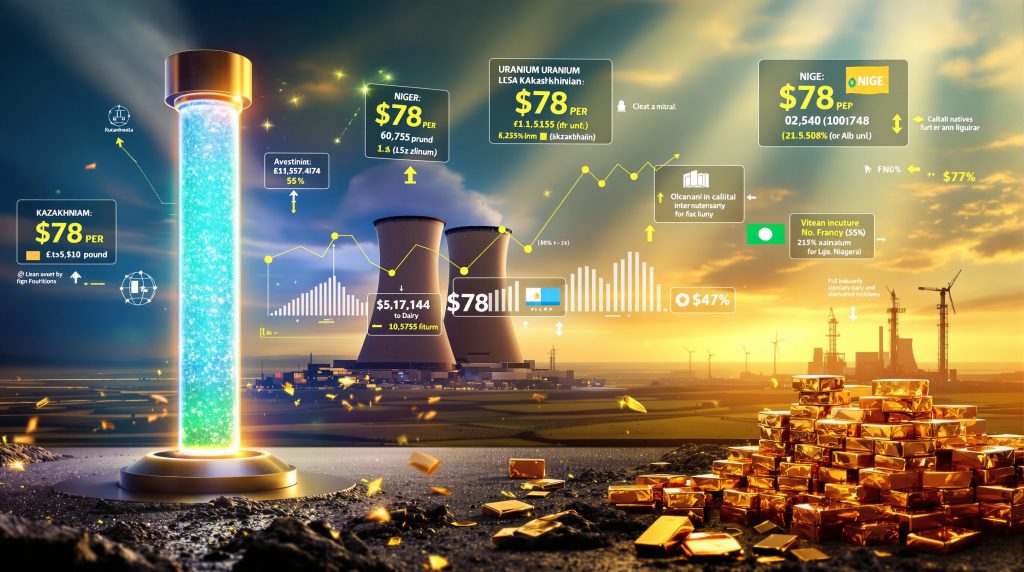Understanding the Uranium Funding Surge: Why Capital is Flowing in 2025
The uranium sector is experiencing unprecedented financial momentum in 2025, with capital flowing into the industry at record levels. This funding surge represents a fundamental shift in how investors, governments, and energy companies view nuclear power's role in the global energy transition.
Key Drivers Behind the 2025 Uranium Funding Boom
The current uranium funding surge is built on several interconnected factors that have aligned to create a perfect storm for investment:
- Price recovery creating investor confidence after years of depressed markets
- Supply constraints from major producing regions creating market tightness
- Government policy support across multiple continents, especially in the US
- Growing demand from traditional and emerging applications like AI data centers
- Strategic capital positioning for anticipated supply gaps forecast through 2030
How Has the Uranium Price Recovery Fueled Investment?
The Price Rebound That Attracted Capital
After years of depressed prices, uranium has staged a remarkable recovery, jumping approximately 24% from March 2025 lows of $63.50 to around $78.56 per pound by mid-year. This upward trajectory has fundamentally changed investment calculations and attracted significant new capital to the sector.
According to market data from the World Nuclear Association, uranium spot prices had been gradually increasing since 2021, but the acceleration in 2025 has been particularly notable and has created a new baseline for project economics.
| Year | Average Price ($/lb) | Year-End Price ($/lb) | % Change |
|---|---|---|---|
| 2023 | $52.25 | $58.75 | +12.4% |
| 2024 | $61.40 | $63.50 | +8.1% |
| 2025 YTD | $72.15 | $78.56 (Aug) | +23.7% |
Why Market Specialists See Further Upside Potential
Market specialists believe the current price remains undervalued when compared to historical inflation-adjusted prices. Industry analysts at Yellow Cake PLC and Sprott Asset Management have suggested fair value estimates closer to $90-110 per pound based on production economics and replacement costs.
This perceived gap between current and potential pricing is driving speculative capital into the sector, with investors anticipating further price appreciation as supply-demand fundamentals tighten.
Industry observers note that current prices remain insufficient to incentivize new mine development at the scale needed to address looming supply shortfalls, suggesting continued upward pressure on uranium prices.
What Supply Constraints Are Magnifying Investment Opportunities?
Geopolitical Disruptions Creating Market Tightness
The global uranium supply chain faces significant challenges that have attracted investment capital seeking exposure to potential shortages:
- Kazakhstan (world's largest producer) reducing output by approximately 20% due to resource depletion in certain areas and infrastructure constraints
- Political instability threatening Niger's uranium exports, with production disruptions reported at key mines
- Concentrated production with top five countries controlling 75% of global supply, creating geopolitical risk premiums
- Secondary supply from weapons decommissioning dropping from historical levels of 24 million pounds annually to under 7 million pounds
According to the World Nuclear Association data, Kazakhstan currently accounts for approximately 43% of global uranium production, making any production issues there particularly significant for global supply. Recent news about Paladin Energy uranium halt in Namibia has further contributed to supply concerns.
The Secondary Supply Cliff
One of the least understood aspects of the uranium market is how significantly secondary supplies have declined over the past decade:
| Year | Secondary Supply (M lbs) | % of Global Demand |
|---|---|---|
| 2015 | 24.2 | 15.8% |
| 2020 | 15.7 | 9.7% |
| 2025 | 6.8 | 3.9% |
This dramatic reduction in secondary supply has created a market gap that mining companies are racing to fill, attracting investment capital to fund expansion and development.
Nuclear industry consultant David Sadowski explained in a recent industry conference, "The market has underappreciated how quickly secondary supplies have declined. The depletion of these inventories means we need more primary production just to maintain current consumption levels."
How Are Government Policies Accelerating Uranium Funding?
Policy Shifts Supporting Nuclear Development
Governments worldwide have implemented supportive policies that have dramatically improved the investment landscape for uranium:
- The Trump administration's domestic production initiatives focusing on energy independence
- Canadian and Australian regulatory streamlining for new nuclear builds and uranium projects
- European Union's inclusion of nuclear in its green taxonomy for sustainable investment
- Japanese restarts of nuclear reactors with government backing for long-term operations
- Supply chain security classifications for nuclear fuel across NATO countries
These policy shifts represent a sea change from the post-Fukushima regulatory environment and have created a much more favorable backdrop for uranium investment. The impact of the US Senate uranium ban impact has particularly accelerated funding in domestic production.
The US HALEU Initiative: A Case Study in Government Support
The United States has committed significant resources to boost domestic production of high-assay low-enriched uranium (HALEU), creating immediate funding opportunities for companies positioned in this space. This initiative represents just one example of how government policy is directly translating into capital flows.
The Department of Energy's HALEU program has attracted both public and private investment to address this specialized fuel need for advanced reactors. Companies positioned along this supply chain are seeing enhanced investor interest as a result. Additionally, advancements in US uranium production technology are creating new opportunities for investors.
Where Is the Investment Capital Coming From?
Diverse Funding Sources Fueling the Uranium Boom
The uranium funding surge is notable for its diverse capital sources:
- Private placements: Exploration and development companies securing oversubscribed financing rounds, often at premium prices to market
- Flow-through financing: Canadian uranium sector seeing explosive growth in this tax-advantaged investment structure
- Strategic partnerships: Major utilities and energy companies taking equity positions in developers to secure future supply
- Physical uranium funds: Financial entities purchasing substantial quantities of physical uranium off market
- Public market capital: Equity investors driving uranium mining stock rallies across major exchanges
- Milestone-based financing: Structured deals tied to development and permitting achievements to manage investment risk
The Flow-Through Financing Explosion
The Canadian flow-through financing mechanism, which allows exploration expenses to be passed to investors as tax deductions, has seen remarkable growth for uranium projects:
| Year | Total Flow-Through (C$M) | Year-over-Year Growth |
|---|---|---|
| 2022 | $32.5 | – |
| 2023 | $53.2 | +63.7% |
| 2024 | $180.8 | +339.8% |
| 2025 YTD | $142.3 | (Projected +210%) |
This dramatic increase in specialized mining financing vehicles demonstrates investor confidence in the sector's near-term prospects, particularly for projects in the Athabasca Basin region of Saskatchewan, including the Patterson Corridor uranium project.
What Demand Drivers Are Attracting Investment?
Traditional and Emerging Applications Creating Demand Growth
The investment case for uranium is strengthened by multiple demand growth vectors:
- Existing reactor fleet: License extensions pushing operational lifespans to 60-80 years
- New reactor construction: China leading with over 22 reactors under construction
- Small modular reactors (SMRs): Moving from design phase to actual deployments with NRC approvals
- Data center power: AI applications creating unprecedented demand for reliable, carbon-free electricity
- Corporate clean energy commitments: Major companies seeking 24/7 carbon-free electricity solutions
The World Nuclear Association reports that global nuclear capacity is projected to grow significantly, with over 60 reactors under construction worldwide as of early 2025.
The AI Power Demand Factor
Artificial intelligence data centers represent a significant new demand driver for nuclear power, with their need for reliable, baseload electricity creating additional investment interest in the uranium supply chain.
Microsoft, Google, and Amazon have all announced partnerships or power purchase agreements with nuclear operators to ensure stable power for their expanding AI operations. This trend represents a new and potentially massive source of demand for nuclear generation.
As one energy analyst noted in a recent industry report: "A single large-scale AI data center can consume as much electricity as a small city. These facilities need reliable, 24/7 power that doesn't depend on weather conditions, making nuclear an ideal partner."
How Are Uranium Equities Responding to the Funding Surge?
Market Performance Reflecting Investor Enthusiasm
Uranium mining equities have responded strongly to the funding surge, with significant share price appreciation across the sector:
| Company Type | Average Share Price Gain (YTD 2025) |
|---|---|
| Major Producers | +42.3% |
| Advanced Developers | +68.7% |
| Early-Stage Explorers | +87.5% |
This performance has created a virtuous cycle of investment, with rising share prices enabling companies to raise additional capital at favorable terms to advance their projects. Despite this positive trend, uranium market volatility remains a concern for some investors.
The explorers' outperformance reflects the higher leverage to uranium price moves, but also the market's growing appetite for earlier-stage opportunities that offer exposure to new discoveries and resource growth potential.
What Are the Key Investment Strategies in the Uranium Sector?
How Capital is Being Deployed Across the Uranium Value Chain
Investors are pursuing several distinct strategies to capitalize on the uranium funding surge:
- Physical uranium accumulation: Purchasing and holding uranium as a commodity, expecting price appreciation
- Producer equity: Investing in established uranium mining companies with existing operations
- Developer funding: Providing capital to advance projects toward production decisions
- Exploration backing: Funding early-stage companies seeking new deposits in prospective regions
- Infrastructure investment: Supporting enrichment, conversion, and fuel fabrication facilities
Each strategy offers different risk-reward profiles and timeframes, allowing investors to tailor their uranium exposure to their investment objectives. According to recent analysis by The Fool Australia, Sprott's doubled investment to $200 million has created significant momentum in ASX uranium stocks.
The Physical Uranium Investment Trend
Funds like the Sprott Physical Uranium Trust have raised hundreds of millions in capital specifically to accumulate physical uranium, removing material from the spot market and contributing to price strength.
This physical uranium investment approach has created a new dynamic in the market, as these funds effectively serve as a buyer of last resort, establishing price floors and reducing volatility while also tightening available supply.
What Challenges Could Impact the Uranium Funding Surge?
Potential Headwinds for Continued Investment
Despite strong momentum, several factors could impact the sustainability of uranium funding:
- Permitting timelines: Environmental and regulatory reviews extending development schedules
- Technical challenges: Mining and processing complexities increasing costs beyond initial estimates
- Public perception: Social license concerns in certain jurisdictions creating project uncertainty
- Alternative energy competition: Renewable plus storage cost improvements changing the energy mix
- Market liquidity limitations: Relatively small market size compared to other commodities creating volatility
Understanding these challenges is essential for investors considering uranium sector allocations, as they represent potential friction points for the current funding surge. The uranium supply shock market dynamics play a significant role in how investors evaluate these risks.
How Can Investors Evaluate Uranium Opportunities?
Key Metrics for Assessing Uranium Investments
When evaluating opportunities within the uranium funding surge, investors should consider:
- Jurisdiction quality: Political stability and regulatory framework for mining operations
- Project economics: All-in sustaining costs relative to long-term price forecasts (not just spot prices)
- Management track record: Experience bringing uranium projects to production, especially through previous cycles
- Financing pathway: Clear route to full funding without excessive dilution at key development stages
- Offtake potential: Relationships with utilities and ability to secure contracts beyond spot market exposure
Mining analyst Rick Rule, known for his uranium market expertise, recently emphasized: "In this uranium cycle, I'm focused on companies with viable projects in tier-one jurisdictions. The premium for jurisdictional quality is only going to increase as the cycle matures."
What Does the Future Hold for Uranium Funding?
Long-Term Outlook for Capital Flows
The uranium funding surge appears sustainable based on fundamental supply-demand dynamics:
- Supply gap widening: Production shortfalls projected to grow through 2030 based on confirmed mine plans
- Reactor pipeline expanding: Over 60 reactors under construction globally with more in planning stages
- Investment cycle timing: Early-stage of a multi-year capital deployment phase based on historical patterns
- Strategic importance growing: Energy security concerns elevating uranium priority in national policies
The Production Gap Challenge
The projected uranium supply-demand balance shows a persistent and growing gap that will require significant investment to address:
| Year | Global Demand (M lbs) | Primary Production (M lbs) | Gap (M lbs) |
|---|---|---|---|
| 2025 | 175 | 145 | 30 |
| 2026 | 182 | 152 | 30 |
| 2027 | 190 | 158 | 32 |
| 2028 | 198 | 163 | 35 |
| 2029 | 205 | 168 | 37 |
| 2030 | 215 | 172 | 43 |
This persistent and growing supply gap underpins the investment thesis driving capital into the uranium sector. As one industry analyst noted, "The gap between supply and demand isn't just a temporary phenomenon – it's structural and widening. That's what makes this uranium funding cycle fundamentally different from previous ones."
FAQ: Understanding the Uranium Funding Surge
Why is uranium funding increasing now after years of underinvestment?
The convergence of rising prices, supply constraints, supportive government policies, and growing demand has created perfect conditions for investment. The nuclear energy narrative has shifted from "sunset industry" to "critical clean energy solution," fundamentally changing investor perceptions.
The timing also coincides with a broader recognition that achieving climate goals will be extremely difficult without expanding nuclear power capacity. This policy realization has translated into tangible support mechanisms that improve the investment case.
How are junior uranium companies accessing capital in this environment?
Junior companies are benefiting from multiple funding avenues including oversubscribed private placements, flow-through financing structures, strategic partnerships with larger companies, and improved equity valuations enabling less dilutive capital raises.
The appetite for earlier-stage uranium projects has expanded dramatically, with investors willing to fund exploration and development activities that would have struggled to find backing just 2-3 years ago.
What role are physical uranium funds playing in the market?
These investment vehicles purchase and hold physical uranium, removing supply from the spot market and contributing to price strength. They provide investors with direct commodity exposure without operational risks associated with mining companies.
The growing assets under management in these funds have created a new dynamic in the uranium market, effectively establishing price floors and reducing available spot market inventory.
How sustainable is the current uranium funding trend?
The fundamental supply-demand imbalance, growing reactor fleet, and multi-year lead time to develop new mines suggest the funding surge has staying power. Unlike previous cycles, today's nuclear renaissance is supported by climate policy, energy security concerns, and emerging applications like AI power demand.
The multifaceted nature of the current demand drivers – spanning from government policy to private sector energy needs – creates a more diversified and potentially durable foundation for continued investment compared to previous uranium market cycles.
Further Exploration:
Readers interested in learning more about trends in uranium investment can explore related educational content from Crux Investor, which provides market analysis and company interviews covering the uranium sector and broader mining industry.
For those seeking deeper understanding of specific uranium companies, it's worth examining the upcoming coverage from the World Nuclear Symposium in London, where key industry players will be discussing their development plans and capital allocation strategies.
Ready to Discover the Next Major ASX Mineral Resource?
Stay ahead of the market with Discovery Alert's real-time notifications of significant ASX mineral discoveries, powered by our proprietary Discovery IQ model that translates complex geological data into actionable investment insights. Explore why major mineral discoveries can lead to substantial returns by visiting our dedicated discoveries page and begin your 30-day free trial today.




